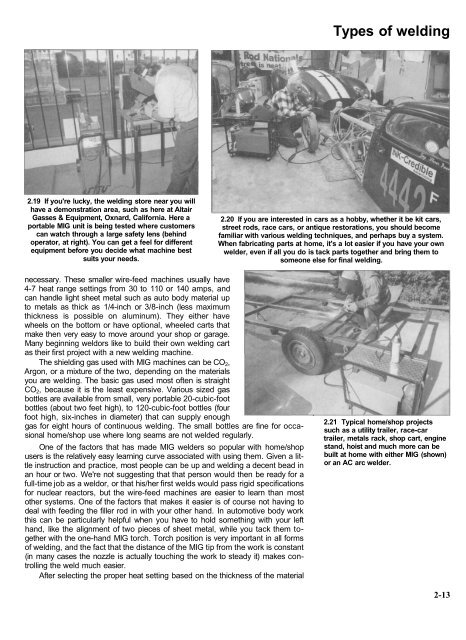The Haynes Welding Manual - VolksPage.Net
The Haynes Welding Manual - VolksPage.Net
The Haynes Welding Manual - VolksPage.Net
Create successful ePaper yourself
Turn your PDF publications into a flip-book with our unique Google optimized e-Paper software.
2.19 If you're lucky, the welding store near you will<br />
have a demonstration area, such as here at Altair<br />
Gasses & Equipment, Oxnard, California. Here a<br />
portable MIG unit is being tested where customers<br />
can watch through a large safety lens (behind<br />
operator, at right). You can get a feel for different<br />
equipment before you decide what machine best<br />
suits your needs.<br />
necessary. <strong>The</strong>se smaller wire-feed machines usually have<br />
4-7 heat range settings from 30 to 110 or 140 amps, and<br />
can handle light sheet metal such as auto body material up<br />
to metals as thick as 1/4-inch or 3/8-inch (less maximum<br />
thickness is possible on aluminum). <strong>The</strong>y either have<br />
wheels on the bottom or have optional, wheeled carts that<br />
make then very easy to move around your shop or garage.<br />
Many beginning weldors like to build their own welding cart<br />
as their first project with a new welding machine.<br />
<strong>The</strong> shielding gas used with MIG machines can be CO2,<br />
Argon, or a mixture of the two, depending on the materials<br />
you are welding. <strong>The</strong> basic gas used most often is straight<br />
CO2, because it is the least expensive. Various sized gas<br />
bottles are available from small, very portable 20-cubic-foot<br />
bottles (about two feet high), to 120-cubic-foot bottles (four<br />
foot high, six-inches in diameter) that can supply enough<br />
gas for eight hours of continuous welding. <strong>The</strong> small bottles are fine for occasional<br />
home/shop use where long seams are not welded regularly.<br />
One of the factors that has made MIG welders so popular with home/shop<br />
users is the relatively easy learning curve associated with using them. Given a little<br />
instruction and practice, most people can be up and welding a decent bead in<br />
an hour or two. We're not suggesting that that person would then be ready for a<br />
full-time job as a weldor, or that his/her first welds would pass rigid specifications<br />
for nuclear reactors, but the wire-feed machines are easier to learn than most<br />
other systems. One of the factors that makes it easier is of course not having to<br />
deal with feeding the filler rod in with your other hand. In automotive body work<br />
this can be particularly helpful when you have to hold something with your left<br />
hand, like the alignment of two pieces of sheet metal, while you tack them together<br />
with the one-hand MIG torch. Torch position is very important in all forms<br />
of welding, and the fact that the distance of the MIG tip from the work is constant<br />
(in many cases the nozzle is actually touching the work to steady it) makes controlling<br />
the weld much easier.<br />
After selecting the proper heat setting based on the thickness of the material<br />
Types of welding<br />
2.20 If you are interested in cars as a hobby, whether it be kit cars,<br />
street rods, race cars, or antique restorations, you should become<br />
familiar with various welding techniques, and perhaps buy a system.<br />
When fabricating parts at home, it's a lot easier if you have your own<br />
welder, even if all you do is tack parts together and bring them to<br />
someone else for final welding.<br />
2.21 Typical home/shop projects<br />
such as a utility trailer, race-car<br />
trailer, metals rack, shop cart, engine<br />
stand, hoist and much more can be<br />
built at home with either MIG (shown)<br />
or an AC arc welder.<br />
2-13

















